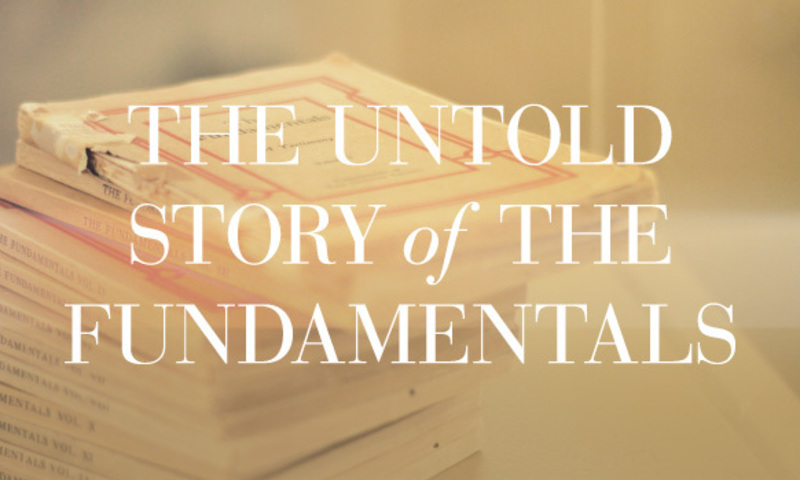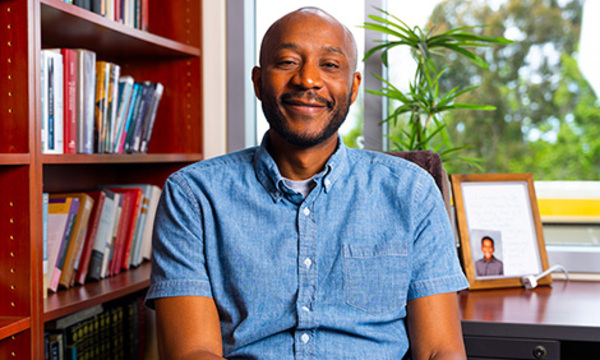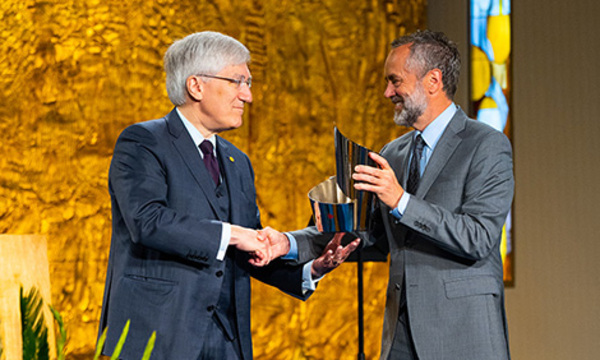A remarkable literary project of the early 20th century, The Fundamentals: A Testimony to the Truth, is soon approaching the 100th anniversary of its completion. The project was conceived and funded by Biola’s founder, Lyman Stewart, mobilizing a network of conservative evangelical writers into a movement in defense of the inspiration and authority of the Bible and the core doctrines of traditional Christian faith.
The 12-volume series of book-length journals contained 90 essays commissioned from leading theologians and religious leaders broadly representing conservative and evangelical Protestantism. Over 3 million volumes were published, distributed free of charge to several hundred thousand pastors, seminary professors and students, missionaries and lay church leaders in the English-speaking world. The effect was both immediate and historically significant.
The series was listed among the top 40 books of the 20th century in a special ranking conducted by Christian historians commissioned by World Magazine. Listing it among the works of C.S. Lewis, G.K. Chesterton, Alexander Solzhenitsyn and Dietrich Bonhoeffer, World reported, ‚Äúthose who consider ‚Äėfundamentalism‚Äô a synonym for narrow anti-intellectualism have never read these books, which, for the most part, remain strikingly relevant.‚ÄĚ A recent special PBS series titled ‚ÄúGod in America‚ÄĚ interviewed leading historians and dramatized the major events in American religious history, including an episode that highlighted the publication of The Fundamentals.
Yet for all its historical influence, the project had unlikely origins. Contained within century-old business records, private letters and other historical documents is an inspiring story of how Stewart gave generously of his wealth, shunned personal attention, assembled a broad coalition of thinkers and followed a calling from God to equip the English-speaking world with a respectful, intelligent defense of the Christian faith.
The Vision: Stem the Tide of Liberalism
The founders of Biola, along with the other evangelical Christians who came of age in the last half of the 19th century, faced an unprecedented series of scientific, social and intellectual challenges to their faith. The Darwinist theory of human origins provided a framework for a purely scientific and naturalistic interpretation of humanity and society. Modern humanistic philosophies and ideologies embraced historical progress. Continental scholars and theologians developed new philological and hermeneutical methods for examining the historical narrative of the biblical text in new ways. Known as German ‚Äúhigher criticism,‚ÄĚ this method applied a developmental view of the Hebrew biblical texts that undermined their sanctity and authority.
These revolutionizing streams of thought prompted many Protestant intellectuals to construct a ‚Äúmodern‚ÄĚ system of religious belief and practice, described as both ‚Äúliberal‚ÄĚ (indicating freedom from tradition) and ‚Äúmodernist‚ÄĚ (indicating alignment with modern science and social theory).
By 1880, liberalism and modernism had begun to be taught in a number of leading theological schools in America, and by the turn of the century it merged into a social theology with powerful appeal to the progressive political movements of the day. The wealth of the Gilded Age also seemed to be in liberalism‚Äôs corner. Access to steel magnate Andrew Carnegie‚Äôs largess tempted many religious institutions to sever their denominational ties and to embrace scientific methods in the humanities as well as in the physical sciences. John D. Rockefeller‚Äôs University of Chicago, according to historian George Marsden, ‚Äúbecame after the 1890s the leading American center for aggressive theological liberalism.‚ÄĚ
Lyman Stewart had for a number of years envisioned a literary project utilizing mass distribution to help stem the tide of modernism. Having successfully overcome financial setbacks and competitive challenges as chairman and president of California's largest oil company for nearly two decades, Stewart collapsed from nervous exhaustion in 1907. On his doctor’s order, Stewart took a six-month break from work, including a long vacation back East at Moody’s Northfield Bible Conference, where he heard the teaching of such stalwart Bible teachers as F.B. Meyer, James Orr, C. I. Scofield and G. Campbell Morgan.
Stewart wrote that summer regarding ‚Äúa matter which had been on our hearts for some time, that of sending some kind of warning and testimony to the English-speaking ministers, theological teachers and students, and English-speaking missionaries of the world ... which would put them on their guard and bring them into right lines again.‚ÄĚ
In February of 1908, Stewart and a group of other evangelical Protestants founded the Bible Institute of Los Angeles (BIOLA) to train missionaries, Christian workers and lay Bible teachers for ‚Äúthe propagation of the old Gospel‚ÄĚ and to remain loyal to ‚Äúthe Word of Truth.‚ÄĚ That August, the Rev. A.C. Dixon held a series of meetings in Los Angeles‚Äô Temple Baptist auditorium. Stewart had heard many positive reports of Dixon‚Äôs vigorous debates with the modernist theologians at the University of Chicago Divinity School. Listening intently in the audience, Stewart was impressed that Dixon had the intellectual strength, vision and temperament to lead his literary project. Dixon agreed to meet with Stewart for a private discussion. After hearing Stewart explain his vision, Dixon responded with enthusiasm, ‚ÄúIt is of the Lord; let us pray.‚ÄĚ
The Team: A Broad Coalition of Scholars
Immediately following his return to Chicago, Dixon composed a list of desired topics and potential writers, including theologians, academics and Bible teachers from North America, Britain and Europe, whom, he wrote, ‚Äú[we] know from good testimony are true to Christ and the Bible and capable of doing the best possible work.‚ÄĚ
The group was broadly diverse. In addition to Dixon, a prominent Baptist, it included such figures as Reuben Archer (R.A.) Torrey, a Yale graduate and Europe-educated evangelist and educator who would later become BIOLA’s dean; James A. Gray, a Reformed Episcopal Bible scholar; Louis Meyer, a scholarly former Darwinist and Reformed Jew who became a Reformed Presbyterian lecturer and writer; and W.J. Erdman, a Presbyterian Bible scholar and one of the founding leaders of the Niagara Bible Conference movement of the late 19th century.
Stewart’s desire for strong leadership representing the broadest possible spectrum of denominational interest and geographic reach set the stage that would later transform this literary project into a theological movement. British participation was enlisted from Sir Robert Anderson, James Orr and the Rev. Thomas Whitelaw, moderator of the United Presbyterian/Free Church General Assembly of Scotland. Orr was professor of historical theology and apologetics at Trinity College, Glasgow, Scotland, and the recognized leader of conservative evangelical scholarship in Britain.
While Dixon assembled his editorial committee, he was equally concerned to engage a circle of spiritual supporters who would uphold the enterprise in daily prayer ‚ÄĒ the prayer circle grew to 5,000 members. The committee also felt that this new broad coalition required a wholly new organization, free of any direct relationship with any existing institution, denomination or school of dogmatic interpretation. The committee agreed to organize themselves as ‚ÄúTestimony Publishing Company,‚ÄĚ and rental space was secured at 808 North La Salle in Chicago, an annex of the Moody Church. Dixon asked Thomas Stephens, the editor of the Moody Church Herald and an experienced businessman ‚Äúwho walks with God,‚ÄĚ to serve as the business manager of the new project. A stenographer, Elsie Behrens, set to work making revisions to the score of manuscripts that had already been received by the end of November.
The Response: A Movement is Born
The first volume was mailed out March 19, 1910, with a cover page stating, ‚ÄúCompliments of Two Christian Laymen.‚ÄĚ (The project‚Äôs funders, Stewart and his brother Milton, chose to remain anonymous.) It contained a strong set of essays on the fundamental doctrines of inspiration and authority of the Bible, the deity of Christ and the personality and deity of the Holy Spirit, authored by such luminaries as professors Orr, Warfield, Torrey and Pierson. The Testimony Prayer League prayed over the mailing lists, the printing presses and daily distributions to the postal office.
The response produced greater results than had even been hoped ‚ÄĒ 2,000 letters a week. Many of the mainline clergy expressed surprise that there were any ‚Äúwho are still standing for the old standards.‚ÄĚ Dixon reported to Stewart, ‚ÄúI am certain that this is the work of the Lord.‚ÄĚ
‚ÄúLike Elijah,‚ÄĚ he said, ‚Äúmany ‚Ķ seem to feel that they alone were standing for the old truths, and finding that there are many other loyal men gives them renewed courage.‚ÄĚ
Ultimately 90 essays, contained within 12 volumes, were published between 1910 and 1915. Over 200,000 letters were received by the Testimony Publishing Company, some antagonistic but most appreciative and grateful for the generosity of the ‚Äútwo Christian laymen,‚ÄĚ desiring more volumes for distribution or committing to prayer for a restoration and revival in the church.
The records clearly reveal that despite the strong personalities involved and the multitude of denominations represented, there was an overriding spirit of irenic cooperation among the committee and a desire to present their written testimony in a winsome and convincing manner.
Early in the project, Stewart had instructed Dixon that there was no room for those who expressed a negative mentality, or a spirit of belligerence or ugliness.
‚ÄúI have observed that some of our best writers sometimes give expression to their righteous indignation in such epithets as ‚Äėfools‚Äô, ‚Äėidiots,‚Äô etc.,‚ÄĚ Stewart wrote. ‚ÄúThis should not be allowed in ‚ÄėTestimony,‚Äô if we are to win to the truth those whose minds the god of this world has so blinded. ... They must not be antagonized, excepting as the truth of God‚Äôs word may antagonize them.‚ÄĚ
Historian George Marsden observed, ‚ÄúNearly everyone who reads The Fundamentals is struck by their relative moderation compared with later fundamentalism.‚ÄĚ The correspondence and editorial reports of the project reveal the careful editorial attention to tone, temperament, factual content and substantiation of argument. Even the detractors of the series commented favorably upon the style of the essays, the ‚Äúphilological accuracy in the use of ancient textual sources‚ÄĚ and ‚Äúcapable use of theological German and Latin.‚ÄĚ
The special burden of leading the editorial work of The Fundamentals‚Äô committee ‚ÄĒ reviewing, selecting and editing over 500 manuscripts commissioned and ultimately selecting the 90 published ‚ÄĒ challenged the three equally gifted, but very different editorial executive secretaries who successively managed the project over a five-year period: A.C. Dixon, Louis Meyer and R.A. Torrey.
Dixon’s passionate zeal and gift of exhortation made possible his organization of an international alliance of writers and committee members. Nevertheless, after two years, Dixon felt deeply mired in the editorial management of his international literary network. Dixon left for London in 1911 to take the pastorate of the Metropolitan Tabernacle, Spurgeon’s former church.
The next editorial secretary, the Hebrew-Christian scholar Louis Meyer, provided improved organizational effectiveness and scholarly talent that enabled the fullest development of the collective ‚Äúmind‚ÄĚ of the movement. Unfortunately, his intensity, rationality and personal commitment drove him to an early grave. Through overwork, he contracted tubercular meningitis and died in a sanitarium while editing the sixth of his Fundamentals volumes. The final editor, R.A. Torrey, used his forceful personality and prestige to bring the project to an effective conclusion focused on evangelical witness.
Torrey would later revise the complete series into a four-volume topically organized edition ‚ÄĒ the version with which most are familiar. A high-level thematic division of the 90 articles can be divided into three parts: a third devoted to safeguarding the Bible, a third dealing with core doctrines other than the Bible, and the final third devoted to the evangelical testimony and critiques of the variant religious, scientific and social thought movements of the day.
The Visionary: An Investment in Eternity
Throughout these five years of business turmoil, more than 450 letters passed between Lyman Stewart in Los Angeles and the project’s team in Chicago. Many were long and detailed operational and editorial reports. Others discussed issues of sensitive theological, organizational or personal concern. These records clearly reveal that Stewart was much more than the financial backer of the project. He was both publisher and chairman of the Testimony Publishing Company, providing strong vision, guidance and executive direction. Still, he freely admitted that he had delegated operational and editorial control to the committee, and it was this spirit of humble collegiality and effective delegation that was critical to its ultimate success.
Writing to Torrey toward the end of the project, Stewart explained his motives. ‚ÄúI do not want my way,‚ÄĚ he wrote in a 1915 letter. ‚ÄúI may have my theories, and perhaps I have wasted the time of my friends in arguing for them ... but had the work of The Fundamentals been carried out in accordance with my original suggestions, it could not have been nearly as effective as through the plan which was adopted by the Committee.‚ÄĚ
In sum, the spirit of The Fundamentals project was infused with a fervent mood of devotion, dedication and responsibility ‚ÄĒ a spirit that each individual member carried with them for the remaining days of their earthly lives.
As Stewart summarized for his brother Milton at the beginning of the project: ‚Äú[W]e must admit that we, you and I, are now old men. We have been so busy, so occupied with the affairs of this life, that old age has crept upon us unawares, and it is time we were seriously taking up the real business of the true Christian life. ‚Ķ Through Paul, the Holy Spirit has given us this admonition, ‚ÄėCharge them that are rich in this world, that they be not high minded, nor trust in uncertain riches, but in the living God, who giveth us richly all things to enjoy; that they do good, that they be rich in good works, ready to distribute, willing to communicate; laying up in store for themselves a good foundation against the time to come, that they may lay hold on eternal life.‚Äô I Tim. 6:17-19.‚ÄĚ
‚ÄúWe both, doubtless, have plans for accomplishing some good with the means which the Lord has so graciously entrusted us,‚ÄĚ Stewart continued. ‚ÄúThis will be such a testimony doubtless as has never before been presented simultaneously to the English-speaking churches. ‚Ķ Can you conceive of a greater and better work in which it would be possible to have a part? Will you join me in it? ‚Ķ It has been my practice for years to offer you an opportunity to invest in the best things I knew of, but this is the best of all, by far.‚ÄĚ
Paul W. Rood II, a retired corporate executive and lecturer in politics and economics at Biola, is currently writing a comprehensive biography of Lyman Stewart, founder of Biola and the Union Oil Company. He has also led the development of a special historical exhibition titled ‚ÄúRemembering The Fundamentals Project: 1909‚Äď1915,‚ÄĚ which is displayed in the main floor of the ļŕ›ģ ”∆Ķ Library through May 2015.
Remembering The Fundamentals
Now through May 2015, the ļŕ›ģ ”∆Ķ Library is hosting a special historical exhibition titled ‚ÄúRemembering The Fundamentals Project: 1909‚Äď1915.‚ÄĚ The exhibition contains examples of the business records and editorial correspondence of The Fundamentals project preserved among the Lyman Stewart Papers in the Biola archives. These archive documents and artifacts along with narrative exhibits will be rotated, refreshed and expanded to encourage visitors to deepen their understanding and appreciation of this remarkable project, an important element of Biola‚Äôs spiritual legacy.
 ļŕ›ģ ”∆Ķ
ļŕ›ģ ”∆Ķ
.jpg)

